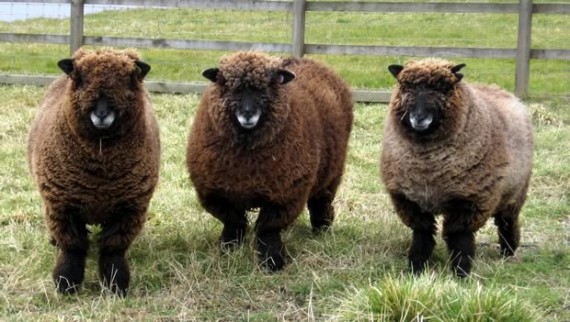Selecting breeding stock - ewes
Only fit, healthy ewes that are good examples of their breed / type should be put to the tup. If a ewe has lambed previously, then previous lambing performance should also be taken into consideration. Ewes that have had problems lambing or raising lambs, that are persistently lame, that have mouth or udder issues should not be put to the tup.
 Jura, Juno and Jinx - our first three ewes, bought from a reputable breeder
Jura, Juno and Jinx - our first three ewes, bought from a reputable breeder
Prolificacy in sheep
Prolificacy (the ability to sustain multiple pregnancies) is an inherited trait. Ewes that are twins are more likely to produce twins themselves than those that were singles; daughters of a tup that was a twin are also more likely to produce twins (which is why record keeping is important).
In commercial flocks, ewes are often systematically culled from the breeding flock at a particular age – this doesn’t mean that individual ewes could not breed again successfully. Hill flocks usually draft ewes after a couple of lambing seasons because life on the hill is hard – these draft ewes are brought on to better pasture and crossed with, for example, the Bluefaced Leicester to produce Mule lambs.
The farm I worked on in my student days had a flock of some 600 Mule ewes. My boss decided that it would be more cost effective to breed his own replacements, buying draft Blackies and borrowing a Bluefaced Leicester tup from a neighbouring pedigree breeder.
The Blackies ran on the farm’s worst pasture and thrived, producing robust, healthy lambs and they were the most amazing mothers (we all had bruises to prove it!). The hardest part was keeping them contained. We had one ewe that decided to live in the garden of one of the farm cottages – no matter how many times we returned her to the field, she returned to the garden.
In the end, we gave up and left her there.
In the small flock, there is no reason why an older ewe should not continue to lamb successfully so long as she is fit and healthy.
Health issues in breeding ewes
The most common problem with older ewes is either loss of front teeth or problems with molars that prevent the ewe eating properly so that she is unable to hold sufficient body condition to sustain a pregnancy. A ewe that has lost front teeth but has good back teeth can be selectively fed to maintain condition – but bad back teeth cannot be compensated for. When selecting ewes, run your hand along the jawline to check for any rough teeth.
Check udders carefully – there should be no lumps, bumps or hard areas. If there are, don’t breed from the ewe as it is unlikely that she will milk well. Ewes with oversized udder or overlarge teats are to be avoided too – both things make it difficult for lambs to suck.
Our oldest ewes were born 2007, so will be lambing for the fifth time this year (2013). They’re all fit and well – two are carrying singles, one has twins.
To be honest, “the originals” will have a home for life here and will slip into happy retirement in a few years.
When to lamb ewes for the first time
One decision that you will have to make at some stage is when to lamb ewes for the first time – as ewe lambs at 12 months of age or as gimmers at around two years old. There are pros and cons for each system but my advice to the new sheep keeper is to lamb as gimmers. You are less likely to encounter lambing difficulties as the ewe is closer to mature size and weight.

About Rosemary Champion
Rosemary lives on a 12 acre smallholding in Angus, in the east of Scotland, where she keeps Ryeland Sheep, Shetland cattle and assorted poultry. She was destined to be a smallholder from an early age.
Further Reading
 Sheep Medicine Phillip R. Scott |  Sheep Health, Husbandry and Disease: A Photographic Guide Agnes C. Winter |  The Veterinary Book for Sheep Farmers David Henderson |  The Sheep Keeper's Veterinary Handbook Agnes Winter & Judith Charnley |  Beautiful Sheep: Portraits of Champion Breeds Kathryn Dun |
Smallholding shop
When you click links below and make a purchase, this may result in this site earning a commission from eBay.

Myti Lite II Lamb Footrot Shears
Lamb Footrot Shears. Narrow… from £11.31 + p&p

Pin Type Ram Crayon - Blue each
Pin Type Ram Crayon. Blue.… from £1.74 + p&p

First 24 POWDER Colostrum 500g 20 Dose
Premium powder lamb… from £20.60 + p&p

7-Rail Galv. interlocking sheep hurdle
7 Rail Sheep Hurdle. 1830mm x… from £27.62 + p&p
















